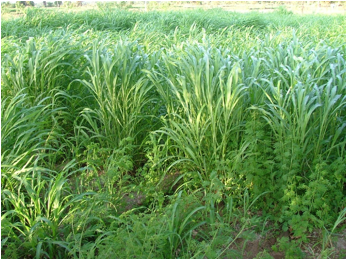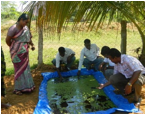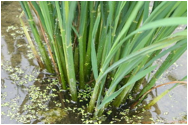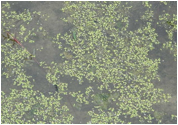
The role of livestock in Indian economy is special one. One fourth of the country’s total revenue is come from the Agriculture. Animal husbandry contributes 33 per cent. Livestock farming is livelihood in villages, it removes poverty of the farmers, helps to improve their economic status. Daily revenue yielding milch cow farming was considered as important profession by the small and marginal farmers. Their milch animals largely depends on plant residues like straw and sorghum stalk, due to this milk production is low.
In integrated farming system, production of Azolla can be utilized for fodder and also as organic fertilizer. In addtion to this, Azolla is become a non chemical fertilizer based alternate fodder. Hence, it is suited to all livestocks. This can be used as protein rich feed there by we can reduce the production cost.
Our Agriculture profession is connected with nature. Our people not only natural lovers in habitat and life style and also they used cow dung, poultry waste and dried leaves are used as fertilizer. This kind of Agriculture provided healthy and wealthy life. But today, synthetic fertilizers are degrading soil fertility. At this point, in integrated farming system with the use of livestock residues panchakavya can be prepared and used for agriculture and fodder crops to minimize disease incidence and growth promoter.
Integrated farming:
In Integrated farming system, agriculture can be integrated with livestock, poultry and fish are maintained at same place to generate employment around the year and also get additional income. For example, same place poultry in upper layer and utilize their excreta. Pigs are in lower layer, residual water from pond was utilized for Agriculture and fodder crops production.
We can see in lot of villages coconut gardens are intercropped with fodder and allow the livestock and country hens to graze the pasture. The excreta can be recycled as manure for garden as well as forage crops is called as integrated farming. Integrated farming system when agriculture was jointly performed with animal husbandry the land, water and plant was fully utilized.
Essential of Integrated farming system:
Places where one crop in a year, scarcity in irrigation and low rainfall areas, Agriculture practiced with animal husbandry not only gives additional income and employment opportunity to the family members around the year and also livestock excreta utilized as manures lowered the cost of fertilizers. Additional yields from crops. Soil fertility was protected. Crop residues used as livestock feed will reduce the feed cost. In this method agriculture along with fodder and azolla production combined with animal husbandry we will get more benefits. In our country, more than 80 % farmers having a hectare or less than a hectare farm holders like small and marginal farmers. So, small and marginal farmers can cultivate part of their land with fodders like sorghum, maize and forage grass like Co-4 and guinea grass and legumes like Pillepesara and Stylo were fed to animals. Small farmer owning one hectare of land could allocate 0.8 hectares of land for agriculture, and 0.2 hectares of land for fodder production with modern technologies and if followed crop rotation, the returns from agriculture, milk and meat were high and realize more income.
Fodder production in integrated farming system:
In integrated farming system, maintenance of cattles, realize more income; good quality fodder production is essential. Fodder cultivation improves soil fertility and soil water holding capacity. Weeds, non-beneficial plants and sedges growth were restricted. Legume fodder cultivation enriches soil nutrients particularly nitrogen.
Profitable milk and meat production requires protein rich legume fodders to be fed to the animal husbandry. Cereal and grass fodders are mixed with legume fodders will reduce the cost incurred for concentrate.
Guidelines for fodder production
- In minimum land high yielding forage varieties must be selected.
- Select forage varieties suitable for both irrigated and rainfed condition.
- Based on soil testing forage crops could be cultivated.
Forage crops can be classified as follows
- Grass fodder
- Grain fodder
- Legume fodder
- Tree fodder
Grass fodders
Irrigated crops: Cumbu-napier hybrid grass and Guinea grass
Rainfed crops : Kollukattai grass and Deenanath grass
Grain fodders
Irrigated crops: Forage maize, forage sorghum, Forage cumbu
Rainfed crops: Forage sorghum, Forage cumbu
Legume fodders
Irrigated crops : hedge lucerne, lucerne, cowpea, cluster beans, Soya , centro
Rainfed crops : Hedge lucerne, stylo, Desmanthes, Ciratro, sangu pushpam
Short term crops: Pigeon pea, horse gram, lablab, cowpea, cluster beans
Fodder seeds, seedlings and fodder cuttings could be purchased at stations of Tamil Nadu Veterinary and Animal Sciences University
1. Veterinary Research Institute, kattuppakkam, Kancheepuram District, Phone: 044-27452224
2. Agriculture Information Technology Center, kattuppakkam, Kanchipuram district. Phone: 044-27452371.
3. Mecherry Goat varieties Research Institute, Pottaneri, Salem District. Phone: 04298-262023.
4. Goat Breeding and Research Centre, Santinalla, Ooty, Phone: 0423-2253089
5. Veterinary Research Institute, Namakkal. Phone: 04286-266491
6. Veterinary Research Institute, Thanjavur. Phone: 04372-234011
7. Veterinary Research Institute, Tirunelveli. Phone: 0462-2336345
8. Krishi Vigyan Kendra, Kunrakkuti, Sivaganga district. Phone: 04577-264288
9. Agricultural Science Institute, Namakkal. Phone: 04286-266345
10. Tamil Nadu Veterinary and Animal Sciences University Research Farm, Madhavaram - Chennai - 51. Phone: 044-25551571
Also,
11. Forage crops, Tamil Nadu Agricultural University, Coimbatore. Phone: 0422- 6611210.
12. Forage production and demonstration Regional Station, Avadi (Alamathy)post, cattle-ranching way, Senkundram, Chennai - 52, Phone: 044-26310360
Approaching these stations you can buy forage seeds and cuttings.
Alternate fodder - Azolla:
Presently, due to low rainfall and decline in cultivable land if alternate fodder was used as feed it can reduce fodder scarcity and cost. Azolla is a chemical fertilizer free alternate fodder,which is a balanced feed for all varieties of cattles.
Ingredients added in livestock feed grain forages such as Maize, Cumbu, Sorghum and ingredients for the preparation of concentrates like oilseeds price hike caused increasing livestock and poultry feed cost increasing day by day. The protein rich Azolla can be used as regular alternate feed for livestock and poultry we can significantly reduce the production. It has been used as best natural fertilizer for rice.
Nutrients in Azolla: Azolla contains 25-30% protein, 14-15% fiber, 3-4% fat, 45-50% carbohydrates, minerals and many micronutrients were available.
Production Methods
- More shallow standing water ponds, paddy / rice nursery
- Cement tanks.
- Silpanulin seat spreaded cavity method

In paddy field, if Azolla added @ one kg per cent and stagnate the water to the level of 5 cm, within two weeks it grown in the entire place.
Cement tank method: 10 feet long, 2 feet wide and 1 feet deep concrete tank spread with 25-30 kg of soil with this mix 5 kg of decomposed dung, with this soils of gravel quarry or well soil @ 100g could be added. Keep the water level up to 5 cm. in this add 5 kg of Azolla within two weeks we can collect 35-40 kg Azolla. Once in ten days pour the cow dung slurry.
Azolla as bio-fertilizer
 
It had ability to fix atmospheric nitrogen. It contains 4.5% nitrogen. For paddy it can be added @ 200 kg per acre. It gives nitrogen source to the crop and 15-20% yield also increased.
Feeding cattle: Production of 1 kg Azolla costs about 0.75 paise only. When Azolla is used as feed it could be mixed 1:1 proportion with concentrates and fed to the cattles. After familiar with this, mulching cows will started to consume Azolla alone. One kg of Azolla equal to 1 kg of oil cake. For mulching cows 1-1.5 kg, white pigs 1-1.5 kg, Goat 300-500 grams, Rabbits 100 grams and 25-30 grams of Azolla for chickens might be given to these animals.
Approximately 15-20% increase in milk production in dairy cows, in addition to this increase in cholesterol and also cholesterol free solids enhanced the milk quality. Azolla feeding chickens showed increase in body weight and size of the egg. Further, egg yolk seems to be dark in colour. So production of Azolla under Integrated farming system is not only gives income and also protect the environment.
Panchakavya: In integrated farming system, Panchakavya prepared from milch cows products, clean the environment, fodder and agricultural crops could be protected from spraying of pesticides.
Production method: Pancakavyam means it includes five components in naturally produced. Maximize the benefits of Panchagavya, mix cow’s milk, curd, ghee, cow dung and urine with this sugar cane juice, coconut water, riped fruit and fermented grapes also to be added in the preparation of Panchakavya.
Materials needed
1. Fresh cow dung - 5 kg
2. Cow’s urine - 3 litres
3. Cow’s milk - 2 litres
4. Cow’s curd - 2 litres
5. Cow’s Ghee - 1 litre
6. Sugarcane juice - 3 litres
7. Coconut water - 3 litres
8. Kal or fermented grape juice - 2 litres
9. Riped bananas - 12
Procedure:
5 kg of dung added with 1 litre ghee in a plastic bucket or pot or cement tub and it should be well mixed. Above mixture has to be stirred 2 to 3 times daily for 3 days and should be mixed. Due to stirring daily, methane gas discharged and enhanced fermentation property of cow dung. In addition to this increased its uses and medicinal properties. At any cost don’t use metals. With the above mixture of cow dung and ghee add other components and mix it well. The mixture was stirred 2 to 3 times daily. The vessel should be kept open. If the flies are coming cover the vessel with mosquito net with aeration. After 20 days later, it is suitable for usage. For the production of one litre it costs about Rs. 18 to 20.
Uses: Panjakavya can be used in Agriculture and fodder crops to control diseases and as growth promoter.
In chickens it was added @ 7.5 g / Kg instead of Antibiotics enhanced body weight than other hens. It was also used as growth promoter for chickens.
Globally, the demand for livestock products has been increasing day by day. To meet out this livestock productivity should be increased in manifold. Livestock not only play a key role in to meet out food demand and also poverty elimination and economic upliftment and there is no doubt on this. So integrated farming system agriculture crops integrated with livestock, poultry and fish farming with the production of fodder, Azolla, Panjakavya like environment friendly pesticides are used means it increased livestock productivity. The improvement in standard of living of the farm holders, there is no doubt back bone of our nation i.e. rural economy will also flourish.
|




